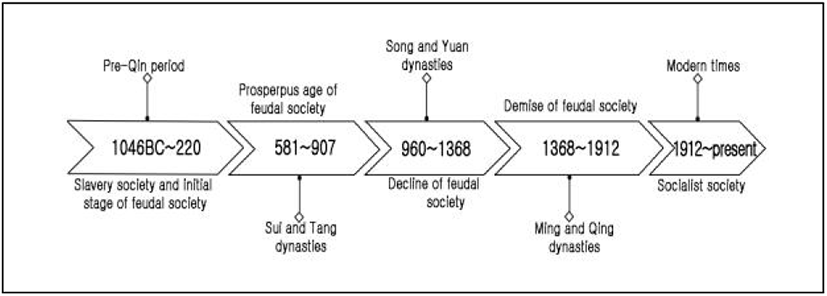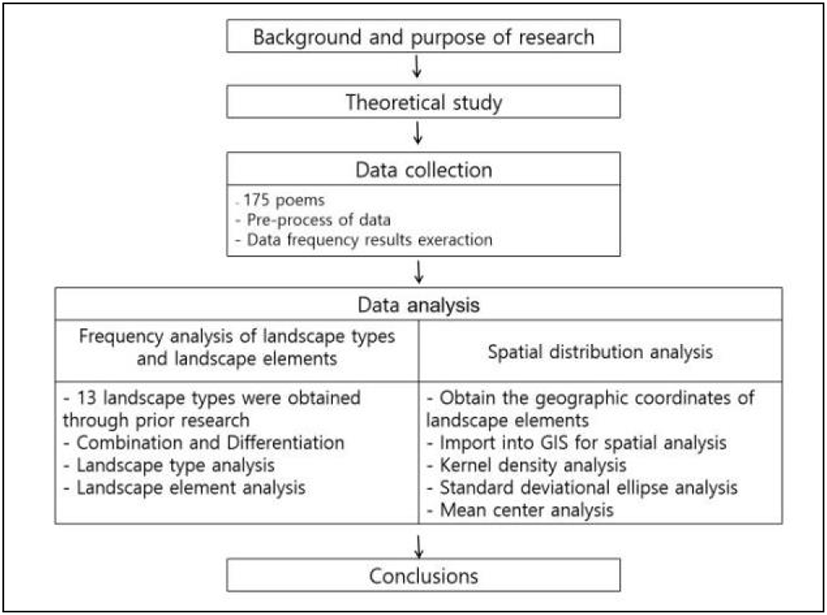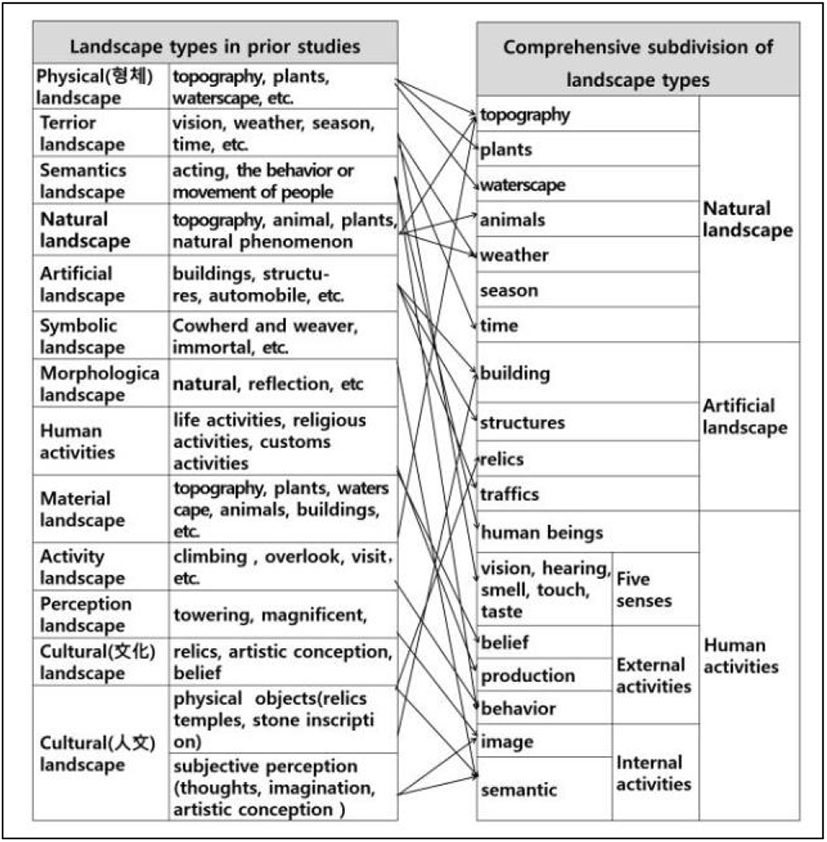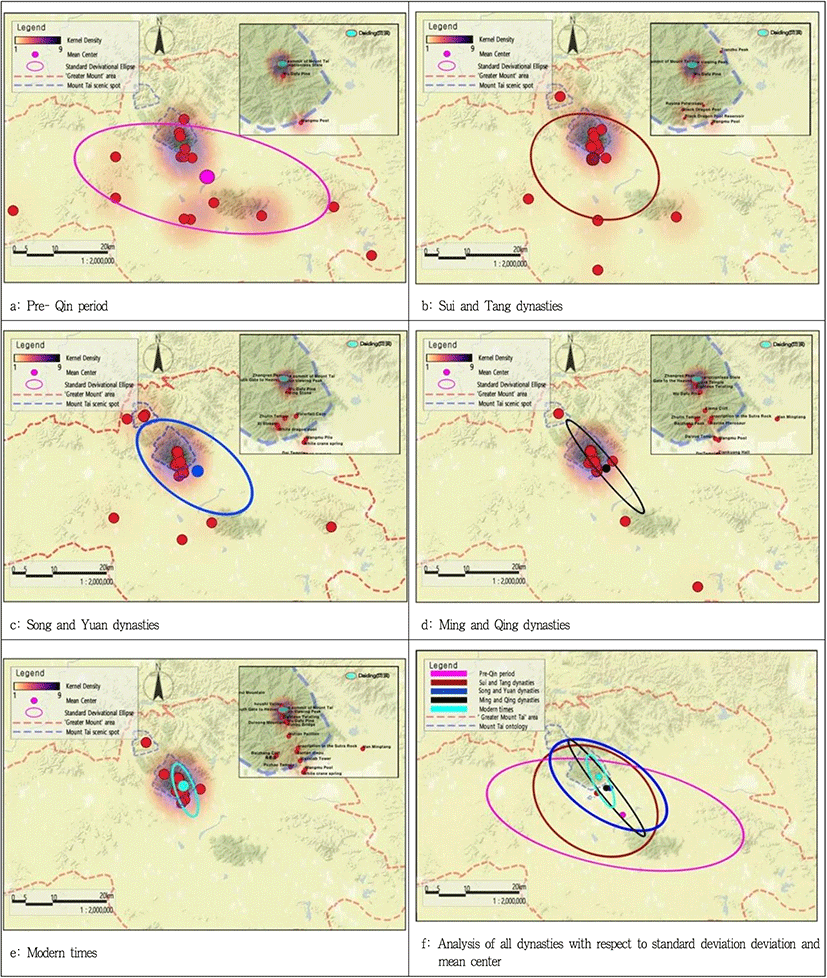Ⅰ. Introduction
Traditional literature is a direct reflection of national characteristics and style of national culture, and it is an important part of humanities. Among them, poetry is the representative of traditional Chinese literature. Poetry describes the author’s initial experience of the landscape with simple and refined words. According to Kato et al. (2001) in Japan, poetry not only contains a large number of humanistic environments and landscapes compared with other historical materials but also reflects the macro-regional image and symbolic significance. If the landscape sites are the same, and the surrounding conditions have not been changed greatly, the feelings of ancient people will not be different with the emotions of people today. But more meaningfully, in the places where ancient people experienced beautiful scenery, one can look at the landscape that changes over time or hasn't changed even if time passes, and ruminate the history. This is the understanding of modernity through poetry. More importantly, it is the understanding of history and the understanding an affection of regions (Park and Lee, 2018). In addition, Chen (1985), a famous Chinese architectural landscape artist, said that Chinese architectural landscape and literature can be traced to the same origin. To study Chinese architectural landscape, many problems can be easily solved by studying poetry.
In 1987, Mount Tai was officially included in the World Heritage List. The World Heritage Committee commented that Mount Tai has been the object of the emperors pilgrimage1)for 2000 years. It perfectly integrates artistic masterpieces with natural landscape. Mount Tai has always been the source of inspiration for Chinese artists and scholars, symbolizing China’s ancient civilization and belief (http://whc.unesco.org/en/list/437/). In 1988, the United Nations Educational, Scientific and Cultural Organization named Mount Tai as the head of the world’s nine natural and cultural heritage (http://www.taiwan.cn/zt/jmkj/jmkj18/syjlt9/200801/t20080102_526017.htm).
Mount Tai is also known as “The First of the Five Sacred Mountains (五嶽之最)”, “The Most Revered of the Five Sacred Mountains (五嶽獨尊)” and “The Head of the Five Sacred Mountains (五嶽之首)”. It is also reputed as “Soul of the country (國之魂魄)” and “Spirit of the nation (民之肝膽)”. At 1532 meters above sea level, Mount Tai is not the highest mountain in China, but it has such a high reputation, which arouses our reflective thinking. In addition, recently Mount Tai scenic spot, like other scenic spots, is moving towards a scenic spot for the purpose of economic development. We can’t find any traces of the landscape of “Yunlong Sanxian (雲龍三現)2)” and “Yangtian Wangfo (仰天望佛)3) in the past. Thus, we can only imagine the beautiful scenery according to the works left by poets at that time.
The existing advance research on Mount Tai mainly focuses on historical materials such as ancient books, local chronicles, inscriptions, travel notes, as well as the areas in the Mount Tai Mountaineering Road (Liu, 2014; Zhang and Zhang, 2019; Yu and Jung, 2020). The research on poetry is mainly about the theme types, geographical images and other literary aspects of poems, therefore, it is inferred that there is a lack of landscape research (Wang and Ye, 2018; Jiang, 2020).
Thus, this study takes poems as research materials to master the landscape characteristics of Mount Tai in the past dynasties, which is of great significance in providing main elements or space for the protection and restoration of Mount Tai landscape in the future.
Ⅱ. Theoretical Study
Landscape elements constitute the basic body of landscape. Mastering the characteristics of landscape elements and the internal correlation of landscape system is helpful to protect the prototype and integrity of heritage value, and is the foundation and necessity to master the important resources and core driving force of the region (Guo and Han, 2021). Wu and Jung (2019) analyzed the landscape characteristics of the ten scenes of West Lake in Hangzhou in terms of natural and artificial landscapes, fixed and changing landscapes, and real and imaginary landscapes based on the frequency of landscape elements appearing in poems and stele pavilions describing the ten scenes. Tsukada et al. (2013) analyzed the landscape impressions of mountains in Japan through text minning based on the frequency of mountain names, images and landscape elements appearing in school songs. In addition, Wang et al. (2020) analyzed the image of Mount Qingxiu through text minning based on the frequency of appearance of landscape elements, using network discourse as research materials. The above-mentioned studies used poems, stele pavilions, school songs, and network discourse as research materials to analyze landscape features or impressions based on the frequency of landscape elements appearing in the texts, but basically focused on the texts without temporal distinction, and therefore judged that the analysis of temporal changes was insufficient. Based on this, this study analyzes the characteristics of landscape elements in Mount Tai according to the time of social development.
Spatial interpretation and analysis of texts is the starting point and an important way of contemporary data analysis research (Zhang and Liu, 2020). Researches based on mathematical models, aided by qualitative analysis and supported by GIS, are usually used in simulating spatial distribution and transformation at present. Among them, Kernel Density, Mean Center and Standard Deviational Ellipse are the most widely used spatial measurement methods. These methods are very useful for describing spatial distribution characteristics (Wu and Lu, 2017). Based on the frequency and quantity, Zhang and Liu (2020) analyzed the temporal and distribution characteristics of landscape in Chinese Tang Dynasty by using kernel density and standard deviation ellipse analysis, and analyzed the reasons for the influence on spatial distribution in combination with the political background. Wu et al. (2016) analyzed the development trajectory of Chinese historical garden heritage through kernel density, standard deviation ellipse and mean center analysis. Rui et al. (2018) analyzed the spatial changes of national garden cities from 1992 to 2018 based on national garden cities and development process. Christopher et al. (2017) also analyzed the visualization of the spatial distribution characteristics of the landscape impressions (beautiful, picturesque, sublime and majestic) of English lakes taking travelogues and geographical literature as research materials. Previous studies have analyzed the spatial distribution characteristics of landscapes or garden cities, but they basically focused on large scale spaces such as national or urban areas. In view of this, this study analyzes the spatial distribution characteristics of the landscape of Mount Tai through the dynasties, starting with the small-scale scenic spots of Mount Tai.
III. Research Scope and Methodology
The study of the history of Mount Tai should be carried out in the range of “Great Mount Tai (大泰山)” area under the historical culture of the mountains in Tai’an and Jinan (Qu and Zhou, 2005). This area is influenced by Mount Tai culture and landscape architecture and is also the reference area of Mount Tai scholars in researching Mount Tai history and culture. The modern Mount Tai scenic spot includes Mount Tai in Tai 'an city, Haoli Mountain (蒿里山), Lingying palace[靈應宮 (Bixia Yuanjun (碧霞元君)'s temple at the foot of Mount Tai], and Lingyan Mountain (靈巖山) in Licheng District (历城区), Jinan City (济南市) (Xu, 2019). Figure 1 shows the spatial scale of this study that is limited to the historical and cultural "Great Mount Tai" region.
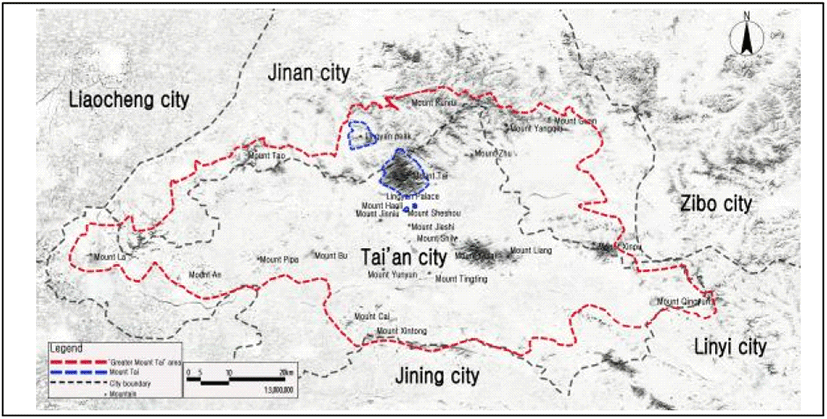
Source: Download with 91 satellite map (Mount Tai in Sandong, China). 2021.04.25. updated date.
The time horizon of this study includes the five corresponding social development stages of Pre-Qin (先秦) period, Sui and Tang (隋唐) dynasties, Song and Yuan (宋元) dynasties, Ming and Qing (明清) dynasties, and Modern times as shown in Figure 2.
The range of content is mainly a collection of works centered on Mount Tai and works published on the official website of Mount Tai Scenic area4). The collection of works includes Selected Poems of Mount Tai in Past Dynasties (泰山历代诗选) (Ma, 1985), Collection of Poems of sages chanting Mount Tai in Past Dynasties (历代先贤咏泰山诗集) (Wang, 2009), and Collection of Poems on Mount Tai (全泰山诗集)5) (Yuan, 2012). In addition, the poems made by famous poets who have influenced literature and society in Chinese classical gardens, landscapes and idylls were selected as representative poems in Chinese dynasties (Pre-Qin period, Sui and Tang dynasties, Song and Yuan dynasties, Ming and Qing dynasties, and Modern times). Considering the limitation of time, 35 representative poems in the Pre-Qin period were selected as the benchmark, and in order to get the common features of all danasties, so 35 poems were selected for each dynasty, totalling 175 poems.
The research method of the study is shown in Figure 3. At first, the data from the selected 175 poems were redefined and the frequency of landscape elements was obtained by using ROST-CM6. Second, the 13 landscape types were derived from the previous studies and then after comprehensive subdivision, they were categorized into the three landscape types including natural landscape, artificial landscape and human activities of Mount Tai. In addition, landscape elements were classified and analyzed by dynasties according to the finally selected landscape type. Third, the landscape elements that can indicate the geographic location information in the poems were imported into the geographic information system (GIS), and the spatial distribution is analyzed through kernel density, mean center and standard deviation ellipse analysis.
In order to ensure the uniformity of data and the accuracy of statistics, we pre-processed the data by redefining the compound words and synonyms such as abbreviations and newly coined words that often appear in poems were interpreted according to the annotations of the poems and the background of their creation, prior studies, and the Chinese ancient dictionary. In addition, after discussing with Zhou Ying (周郢), an expert in Taishan studies, we redefined the meaning of the landscape elements that appear in the poems. For example, although the names of “Wu pine (五松)", “Wu Dafu (五大夫) pine", “Qin pine (秦松)", “Dafu Pine (大夫松)" are different, the object of description is "Five Dafu Pines", so we redefined them as "Five Dafu Pines", in the same way a total of 53 data are redefined in this study.
This study classifies landscape types and landscape elements after analyzing the existing studies. Huh (2019) categorized landscape elements for Palgyung on Soando in Wandogun into physical landscape, terrior landscape, and semantics landscape. Sim et al. (2010) categorized the landscape elements of Gwanghalu Garden into natural landscape, artificial landscape, and symbolic landscape through the interpretation of historical literatures. Ryu et al. (2004) analyzed the poems of 16 sceneries of Hahoe Village and classified the landscape elements into morphological landscape, semantic landscape, and terrior landscape. Chen et al. (2020) categorized the temple garden landscape as material landscape and cultural (文化) landscape. Du and Zhou (2019) used poetry as a research material to classify the space of Wanzhou(萬州) gardens into material landscape, activity landscape, and perception landscape. Landscape can be divided into the natural landscape and artificial landscape according to whether human activity is involved or not (Norman, 2015). Japan's Shinohara (2010) emphasized that landscape is not only a natural and artificial landscape element but also an important element of human activities. Shen (2005) divided the cultural (人文) landscapes appearing in poems into physical objects (relics, temples, and stone inscription) and subjective perceptions (thoughts, imagination, and artistic conception).
Analyzing the above studies, a total of 13 types of landscapes such as physical landscape, terrior landscape, and semantic landscape and so on are derived. In terms of the content of landscape types, the physical objects can be divided into natural landscape and artificial landscape according to whether they are interfered with by human beings or not. There is also the subjective psychological perception of people’s psychological impressions of the scenery, the artistic conception of the landscape and the symbolic meaning, etc. that people are influenced by their beliefs or thoughts. Another kind is the activity landscape formed by people's production, life activities or customs activities and the behavioral landscape formed by people's actions such as climbing, overlooking, and visiting when enjoying the landscape. Production, life activities, climbing, overlooking are intuitive external activities. Subjective perception of the landscape, imagination or symbolism are the inner activities. Both extrinsic and intrinsic activities are human activities (Li, 1999).
People are influenced by beliefs such as Taoism or Buddhism, and the activities of 'Fengshan' or sacrifice are called belief activities, while agricultural production, industrial production, and lives formation are called production activities (Shinohara, 2010). Climbing, overlooking and visiting are human activities. Images of mental perceptions (towering, magnificent) and imaginary symbolic meanings (gods, thoughts, mythical animals, etc.) about the landscape are called semantic landscapes (Lee et al., 2015).
Therefore, in this study, physical landscapes (topography, plants, waterscape, animals, weather, seasons, time) that are not formed by human action are categorized as natural landscapes, and physical landscapes formed by human action (buildings, structuresm, relics, traffic) are categorized as artificial landscapes. In addition, the subject of activity (human), senses (five senses), external activity (belief, production, action) and internal activity (image, semantic) will be classified as human activities (Refer to Figure 4).
The spatial distribution analysis of landscape elements limited the location of landscape elements described in the poems to those that can be confirmed in geographic coordinates.
Kernel density analysis is a method that uses nonparametric estimation to calculate the unit density of point and line elements within a certain range. The concentrated regions of spatial distribution can be mastered through this kind of analysis (Wu and Lu, 2017).
Mean center analysis refers to the central position of data distribution in space, through which we can obtain the central position changes of spatial distribution in past dynasties.
Standard deviation ellipse analysis is the trajectory of the change in the spatial distribution of the point data presented by Lefever (Wu and Lu, 2017). The ratio of the difference between the long axis and the short axis of the ellipse to the long axis is the eccentricity of the standard deviation ellipse, which means the dispersion degree of spatial distribution. The value of eccentricity is between 0-1, and the greater the value of eccentricity is, the more concentrated the spatial distribution of landscape elements will be, showing a linear distribution. The lower the value of eccentricity is, the more dispersed the distribution will be. Through analysis, we can realize the dispersion or concentration of the spatial distribution of landscape elements in the past dynasties.
IV. Results and Discussion
A total of 721 landscape elements are obtained by analyzing the 175 representative poems of Mount Tai, as shown in Table 1, They are further divided into three landscape types: natural landscape, artificial landscape and human activities.
Generally, the landscape of Mount Tai is dominated by human activities (321), supplemented by natural landscapes (298) and artificial landscapes (102). This result is different from the results of the previous studies on scenic spots (Derungs and Purves, 2014).
From the perspective of landscape types, topography is the most frequent element in natural landscape, building is the most frequent element in artificial landscape, and behavior (belief, production, activities) is the most frequent element among human activities. Overall, the importance sequence of landscape elements is semantics, behavior, topography, Waterscape, and plants.
From the perspective of dynasties, the natural landscape of Mount Tai is relatively stable regardless of time, and the artificial landscapes gradually increases. On the contrary, human activities shows a decreasing trend.
In order to grasp the characteristics of landscape elements in past dynasties, the frequency of landscape elements is analyzed (Refer to Table 2).
The landscape elements in this study are classified according to the specific meanings embodied in the poems.
South Gate to Heaven(南天門)* is a stone arch located at the end of Mount Tai's Eighteen Pan(十八盤). Dragon Chariot(龍輦)*is the Carriage of emperors in old days.
Benevolence* is the core of Confucianism. Dojo(道場)*is a large-scale chanting or kneeling ceremony in Buddhist and Taoism. Divine Dragon(神龍) is the mythical animals of the poet's imagination.
The invariance of landscape elements is the landscape element with high frequency in all dynasties, and is an important landscape element in every dynasty. As shown in Table 3, the natural landscape includes “the summit of Mount Tai” and “continuous peaks (连峰)” in topography, “pines” and “Wu Dafu Pines” in plants, “springs” and “streams” in waterscape, “sky”, “clouds” and “sunrise” in weather. Besides this, the “stone inscriptions” in the relics of artificial landscape, the “cyan” in the vision, the “towering”, “magnificent” and “Divine Dragon” in the semantics of human activities are important landscape elements in every dynasty. The important landscape elements in the natural and artificial landscape in this study are almost the same as those in previous studies (Xu, 2019).
In addition, among the landscape elements frequently appearing in the five dynasties, the symbolic meanings of “sunrise”, “cyan”, “towering”, “magnificent” and “Divine Dragon” can explain the reason why Mount Tai is “Soul of the country” and “Spirit of the nation”. Ancient people, influenced by the sun worship in nature worship, considered "sunrise" as a symbol of hope and brightness. Moreover, Mount Tai located in the east of China, is the earliest mountain in China to see the sunrise, it further strengthenes the symbolic meaning of hope and brightness for Mount Tai (Shen and Zhang, 2005).
According to the Five-colors theory (五色说), cyan is a symbol of vitality and prosperity, so Mount Tai also has the meaning of vitality and prosperity (Shen and Zhang, 2005).
“Towering” and “magnificent” accord with the lofty beauty (高大美), the magnificent beauty (壮丽美) and masculine beauty (阳刚美) in the category of ancient Chinese aesthetics. At the same time, in Chinese traditional consciousness, these kinds of lofty beauty, magnificent beauty and masculine beauty are connected with the stability and prosperity of the national society, so Mount Tai can be interpreted as a symbol of the stability and prosperity of the state (Shen and Zhang, 2005).
In the Theory of the Four Gods (四神说) in China, the “Divine Dragon” is the head of all mythical animals, so the Divine Dragon for Mount Tai also symbolizes the head position among all mountains (Shen and zhang, 2005).
The variability of landscape elements is a landscape element whose frequency changes greatly over time. According to the results in Table 2, the frequency of waterscape “streams" in natural landscape shows an increasing trend. As time goes by, it can be seen that the importance of “streams" is increasing. “Fengshan (封禅)” in belief from the Pre-Qin period to the Song and Yuan dynasties, “continuous peaks” and “the summit of Mount Tai” in topography from the Ming and Qing dynasties to modern times have appeared the most times, which can be seen as important landscape elements.
In addition, in the human activities, “Fengshan” in belief and “immortals” in semantics have the highest frequency in the Pre- Qin period and gradually decreased in the Song and Yuan dynasties. “Fengshan” completely disappeared in modern times and “immortals” continued to reduce. In contrast, from Song and Yuan dynasties to modern times the frequency of “climbing” and “looking far into distance” in behavior gradually increased. That is to say, the closer it comes to modern times, the greater human bahviours increase. Therefore, over time, landscape elements evolve from belief landscape to landscape experience.
The geographical locations of landscape elements described in poems of past dynasties can be determined, as shown in Table 4. There are 17 locations in the Pre-Qin period, 17 in the Sui and Tang dynasties, 25 in the Song and Yuan dynasties, 26 in the Ming and Qing dynasties, and 28 in modern times, a total of 113 locations. The spatial distribution results are shown in Figure 5.
To understand the concentrated distribution space of landscape elements in Mount Tai in the past dynasties, the kernel density analysis was carried out according to the frequency of landscape elements in poems. In the Pre-Qin period (Figure 5a), “Liangfu Mountain (梁父山)”, “the summit of Mount Tai”, “Culai Mountain (徂徠山)”, “Haoli Mountain (蒿里山)”, “Yunyun Mountain (雲雲山)” appeared most frequently. In the Sui and Tang dynasties (Figure 5b), “the summit of Mount Tai”, “Sun Viewing Peak (日观峰)”, “Lingyan Mountain (灵岩峰)”, “Tingting Mountain (亭亭山)” and “Liangfu Mountain” appeared most frequently. In the Song and Yuan dynasties (Figure 5c), “the summit of Mount Tai”, “Sun Viewing Peak”, “Lingyan Mountain”, “South Gate to Heaven (南天门)” and “Zhangren Peak (丈人峰”) appeared most frequently. In the Ming and Qing dynasties (Figure 5d), “the summit of Mount Tai”, “Sun Viewing Peak”, “South Gate to Heaven”, “Culai Mountain” and “Eighteen pan (十八盘)” appeared most frequently. In the modern (Figure 5e), “the summit of Mount Tai”, “Sun Viewing Peak”, “South Gate to Heaven”, “Wu Dafu Pine” and “Bixia Temple (碧霞祠)” appeared most frequently. Therefore, it mainly focuses on the space above South Gate to Heaven (“South Gate to Heaven”, “Sun Viewing Peak”, “the summit of Mount Tai”, and “Bixia Temple”) regardless of time. The area above the South Gate to Heaven of Mount Tai is called Mount Tai Daiding (岱顶) (Shen and Zhang, 2005), so it can be judged that it is very important to preserve Mount Tai Daiding in the future.
In order to find the central changes of the distribution of landscape elements in the past dynasties, the mean center analysis was carried out. In the Pre-Qin period (Figure 5a), the mean center was located in the south outside of Mount Tai and in the middle of Liangfu Mountain, Culai Mountain and other mountains. Compared with the Pre-Qin period, the mean center in the Sui and Tang dynasties (Figure 5b) moved northward, and was closer to Mount Tai. The positions in the Song and Yuan dynasties (Figure 5c), Ming and Qing dynasties (Figure 5d) did not change much, which are located in the east of Sui and Tang dynasties. The mean center of Modern (Figure 5e) continues to move northward, close to the summit of Mount Tai. Therefore, from Pre-Qin period to the modern times (Figure 5f), the spatial mean center of landscape elements moved from the south outside of Mount Tai to the summit of Mount Tai.
In order to find the spatial distribution characteristics of landscape elements of Mount Tai in past dynasties, standard deviation ellipse analysis was carried out. From Pre-Qin periodto modern times, the spatial distribution of landscape elements was not uniform. In the Pre-Qin period (Figure 5a), the eccentricity is 0.56, which is similar to the range of “Great Mount Tai”, showing a widely scattered distribution pattern. However, in the Sui and Tang dynasties (Figure 5b), compared with the Pre-Qin period, the eccentricity is 0.31, presenting the most dispersed distribution pattern. Comparing with Sui and Tang dynasties, Song and Yuan dynasties gradually decrease, and the eccentricity is 0.66, showing a linear trend. Compared with the Song and Yuan dynasties (Figure 5c), the eccentricity of Ming and Qing dynasties (Figure 5d) is 0.90, showing a linear shape. The eccentricity is 0.76 in modern times (Figure 5e), which occupies the narrowest range, with a linear growth. Therefore, from the Pre-Qin period to modern times (Figure 5f), the widely scattered distribution has changed to narrow linear distribution centered on the summit of Mount Tai.
V. Conclusion and Recommendation
In this study, in order to get insights of the landscape characteristics of Mount Tai, the landscape types and elements of Mount Tai were analyzed, and the spatial distribution of landscape elements was analyzed for each dynasty. The conclusions of this study are as follows.
First, among the landscape types of Mount Tai, the landscape elements of human activities (45%) appear the most frequently, which is different from the previous studies on scenic spots focusing on natural landscape. It can be seen that Mount Tai attaches great importance to the interaction with the landscape and the participation in activities.
Second, it confirms the importance of “sunrise”, “cyan”, “towering”, “magnificent” and “Divine Dragon” in the landscape elements of Mount Tai, which can be interpreted as symbolization of hope and brightness, vitality, national stability and prosperity, and the leader's position of Mount Tai. This will be helpful to provide the focus of landscape’s placement in the future protection and promotion of Mount Tai landscape.
Third, in the landscape elements of the past dynasties, the belief “Fengshan” (26) appeared the most frequently in Pre-Qin, Sui and Tang dynasties, and the action “climbing” (11), “looking far into distance” (8) appeared the most frequently in the modern times. This can explain that the landscape of Mount Tai has changed from belief landscapes to experience landscapes.
Fourth, in terms of spatial distribution of landscape elements, all dynasties concentrated on the summit of Mount Tai. The mean center moved from the south outside of mount Tai to the summit of Mount Tai, and the overall distribution changed from widely scattered distribution to narrow linear distribution centered on Mount Tai. This will provide basic materials for the future restoration of important areas and historical spaces of Mount Tai scenic spot.
Through this study, the following recommendations are put forward for the future protection of Mount Tai landscape and propaganda of history and culture.
First, strengthen the participation of tourists by setting up interesting games or activities related to Fengshan in the scenic spot of Mount Tai. For example, according to the historical characteristics of different dynasties, the scenes of Fengshan depicted in the historical places on Mount Tai could be played with multimedia technology, so that visitors can participate in the guessing game of historical characters or historical events. Second, emphasize the symbolic significance of Mount Tai focusing on the symbolic landscape features of Mount Tai. For example, enhance the symbolic “Divine Dragon” element. According to the “Yunlong Sanxian” landscape described in the poem, combined with modern information technology (IT), reproduce the beautiful scenery described in the poem, allowing people to experience the artistic conception and symbols in the poem, and enhance the sense of identity of Mount Tai as “Most Revered of the Five Sacred Mountains”. Third, inherit the traditional belief landscape. The landscape of belief is reduced because people's understanding and cognition of belief is insufficient. So we should consider inheriting the belief. For example, the best overlooking position and field of vision should be set for the landscape of “Yangtian Wangfo" with the characteristics of the past. This can not only enable people to continue the traditional belief landscape of Mount Tai, but also increase their understanding of Mount Tai belief. Fourth, propagandize Fengshan culture in history and restore the landscape of the relevant space. For example, on the one hand, we should protect the Daiding space of Mount Tai which is valued by all dynasties. On the other hand, we should take the places where ancient emperors carried out the activity of Fengshan as the starting point of Fengshan cultural landscape, such as Haoli Mountain, Liangfu mountain, Sheshou mountain (社首山), Tingting mountain and Yunyun mountain. It is also necessary for us to extend the landscape of Mount Tai to the South and rebuild the places where emperors offered sacrifice. Therefore, when establishing a comprehensive plan for the restoration of the landscape of Mount Tai in the future, we should consider the scattered distribution of Fengshan culture in the past, so as to help tourists understand the history and culture of Mount Tai and promote the sustainable development of Mount Tai scenic spot in the future.
This study cannot represent all characteristics of the landscape of Mount Tai through the frequency of landscape elements, which is the limitation of this study. Therefore, the meaning of the poem is also important, which will be the subject of future research to be conducted.

